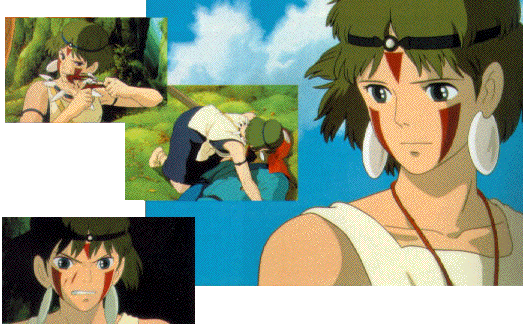Thirteen years after Hayao Miyazaki animated "Kaze no Tani no Nausicaa" (Nausicaa of the Valley of Wind, 1984), Japan's greatest animation director finally made "Mononoke Hime" (The Princess Mononoke, 1997) as his "sequel" to "Nausicaa." As one of the most talented directors/ animators/ manga writers Japan has ever produced, Miyazaki has frequently been dubbed the "Walt Disney of Japan" (although he probably dislikes the title himself). Miyazaki's "Nausicaa of the Valley of Wind," a movie based on his epic manga series, was the first animated feature produced by Studio Ghibli. Unlike the anime, however, Miyazaki took twelve years to conclude "Nausicaa" through seven manga volumes, whereas the animated version only covers the first two novels. "The Princess Mononoke" completes the unanimated ending of the manga "Nausicaa," through a completely different story that carries the same theme.

Both "Nausicaa" and "Mononoke" are movies that
explore the meaning of "living in the middle of destruction and despair,
and overcoming hatred and vengeance." When Miyazaki began writing Nausicaa
in 1982, the story had a simple black and white view of humanity/pollution
versus nature/purification. As he continued to write the story throughout
the 80s, Miyazaki "realized that this was too simplistic an ideal,
and the manga took on a more complicated and ambiguous view of nature and
human." Upon the conclusion of "Nausicaa", Miyazaki showed
that a perfect co-existence between human and nature is virtually impossible.
Thirteen years after animating "Nausicaa," "Mononoke Hime"
proves to be the thematic or spiritual sequel to Miyazaki's film, carrying
out his thoughts and themes from the rest of the manga.
Unlike the animated version of "Nausicaa," Miyazaki's "Mononoke" does not define who is "right" or "wrong," in a conflict between civilization and nature. "Mononoke" takes place during the Muromachi Era (1392-1573) in Japan, as there is a war between a group of working class people (the Tatara) and the "raging animal gods" of the primal Japanese forests. A young boy, Ashitaka, somehow finds himself in the middle of this chaotic battle, as he hopes to purify himself for shedding the blood of an animal god that threatened to destroy his village. However, fighting alongside the divine animals is a young girl, San (Princess Mononoke), who was raised in the woods by Moro no Kimi (a female wolf god). Amidst the chaos of war, Ashitaka and San encounter each other, and the young warrior tries to persuade the San to become "human." By the end of the movie, the two youths "come to an understanding of each other's world and make an attempt to coexist without hatred and violence."
Miyazaki once mentioned that:
"We are not trying to solve the [modern] global problems. There cannot be a happy ending to the fight between raging gods and humans. However, in the middle of the hatred and killings, there are things worth living for. A wonderful meeting, or a beautiful thing can exist."
In "Mononoke Hime," the Tatara developers are not portrayed as senseless offenders of nature; "They cut down trees to make steel so that the disadvantaged can have a place in society," yet the animal gods of the forest have every right to be angry. Miyazaki raises a question about man's place in nature, but does not answer it: he wants his audience to make the judgment.
Although "Mononoke Hime" took three years to animate, the film essentially took thirteen years to evolve from Miyazaki's "Nausicaa." Of course, thirteen years after the first success of Studio Ghibli, only now will a wider audience be able to recognize Miyazaki's works, through the Disney/Tokuma deal (giving Disney international rights to nine animated titles from Ghibli, the last six of which were top box-office hits in Japan). At best, "Mononoke" has been called "a powerful compilation of Miyazaki's world, a cumulative statement of his moral and filmic concern; at worst, [people have said] that the director may be losing his originality in his old age." Although "Mononoke Hime" proves to be more controversial and didactic than most of Miyazaki's other works, his sense of optimism is something that remains consistent in all of his creations, as he believes that:
"The world is profound, manifold and beautiful... Although the world's beset with lots of seemingly intractable problems, such as population explosion and environmental disruptions, making it difficult to entertain hope, it's nevertheless a wonderful thing to live."
Notice: HELP TEAM GHIBLINK! As their page indicates, "Nausicaa.net was hacked, and all data was lost. The site will be down until further notice." Find out how you can help Team Ghiblink restore Nausicaa.net!

Mini Gallery
Links
Feel free to write to me (Gale) about your comments!
This page has been visited  times since September, 1997.
times since September, 1997.